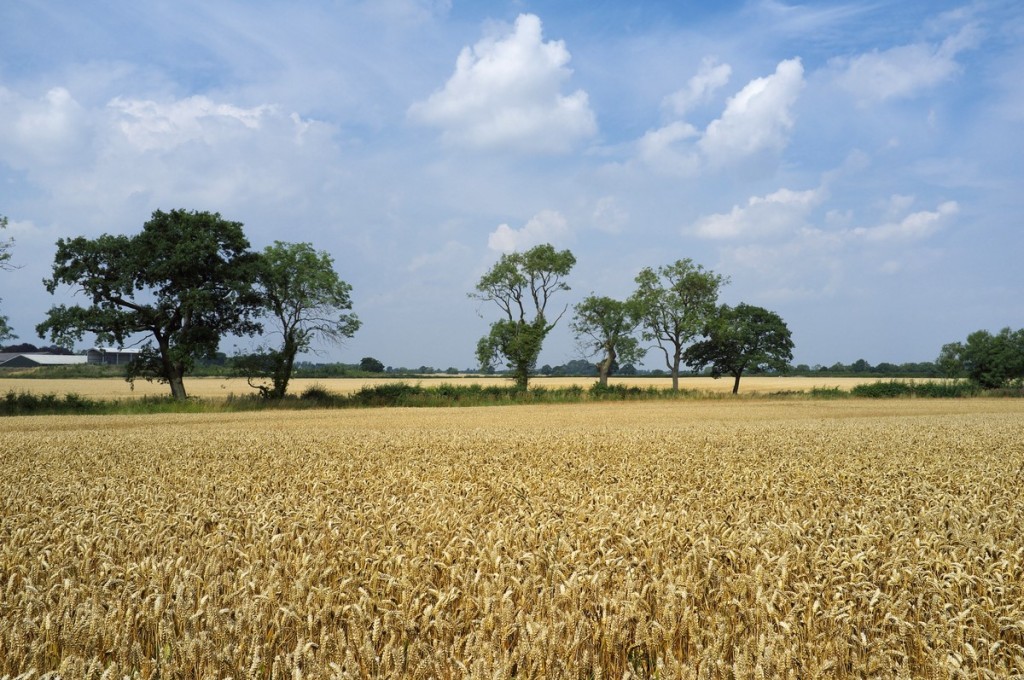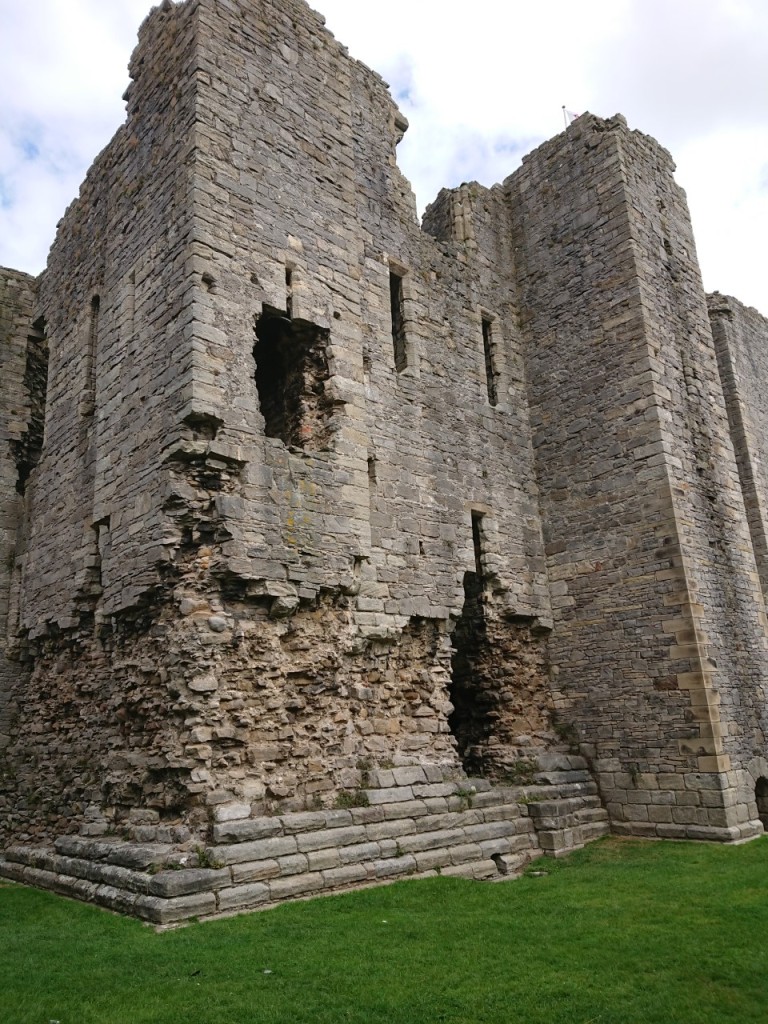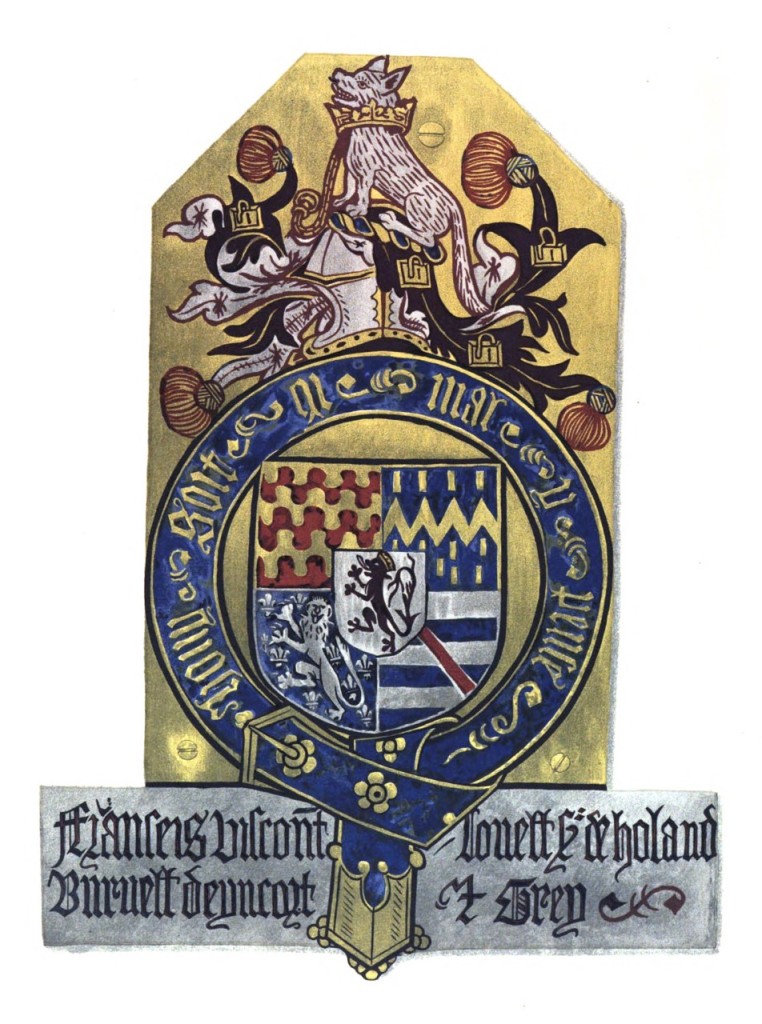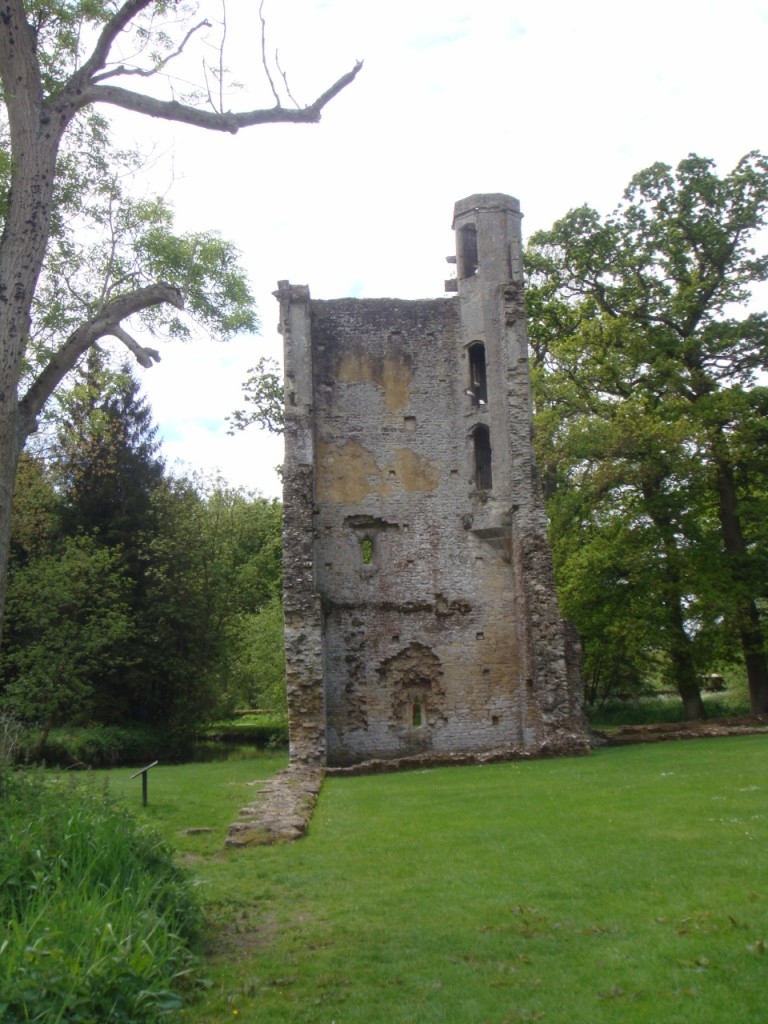Today it is a pleasure to welcome back Monika E. Simon to the blog, with a second guest blog post. This time we are looking at Francis Lovell, close friend of Richard III who seems to have disappeared after the 1487 Battle of Stoke and the defeat of the forces of pretender Lambert Simnel. Monika’s debut book, From Robber Barons to Courtiers: The Changing World of the Lovells of Titchmarsh, is out at the end of the month.
The elusive life of Francis, Viscount Lovell
On 24 May 1487 a young boy was crowned Edward VI in Christchurch Cathedral in Dublin by William FitzSimon, Archbishop of Dublin. A large number of Irish bishops, abbots, and priors attended the ceremony, as well as many Anglo-Irish nobles, including by Garret Mor FitzGerald, Earl of Kildare, and a contingent of English noblemen who had never accepted the Henry VII as king or who had abandoned him later. Most notable among these group were John de la Pole, Earl of Lincoln and Francis, Viscount Lovell, the nephew and best friend of the previous king Richard III, respectively.
Francis Lovell had been chamberlain of Richard III and was lampooned in William Collingbourne’s often-quoted doggerel, alongside William Catesby and Richard Ratcliffe:
“The catte, the ratte, and Louell our dogge,
Rulyth all Englande vnder the hogge”
Slanderous as the rhyme is, it is also quite memorable and probably one of the most famous quotes of this period.

(Daveleicuk, CC BY-SA 4.0 <https://creativecommons.org/licenses/by-sa/4.0>, via Wikimedia Commons)
Francis Lovell is without doubt the most famous member, not to say the only famous member of his family. However, despite his fame he is a ‘shadowy presence’ to us, to use my favourite description coined by J.M. Williams. The information that can be gathered from the existing records leaves us with huge gaps in our knowledge of his life and not only where one would expect them. While it usual that there are no records of his birth, it is surprising that for three years after coming of age and gaining full possession of his estates in 1477 Francis Lovell is not mention in governmental records. Nobleman like Francis Lovell were normally involved in the administration of the country and individual counties, where their estates were situated. It was not until 1480 that his name appears in the Patent Rolls, when he was appointed to a commission of array in the North Riding of Yorkshire.
Thanks to the fortunate survival of the Paston Letters we know Francis Lovell was married in 1466, at the age of about ten, to Anne FitzHugh, daughter of Henry FitzHugh and Alice Neville, the sister of Richard Neville, Earl of Warwick, ‘the Kingmaker’. Interestingly, it was only a year later, on 19 November 1467 that his wardship and marriage was granted to the Earl of Warwick. Francis Lovell’s father had died more than two years earlier, on 9 January 1465 and his mother a year later and a half later, on 5 August 1466. It is possible that in the period between his father’s death and the grant of his wardship to the earl of Warwick, Francis Lovell had remained a ward of the king, but the fact that he was already married to the earl’s niece when the grant was recorded could mean that his warship had already been given informally to the earl.
Francis Lovell joined the household of the earl of Warwick at Middleham and it is often assumed that it was in this period he became a close friend of Richard, Duke of Gloucester, who was staying with the earl in the same time. However, it is not known when Francis reached the Yorkshire castle nor how long Richard stayed there. It is possible that the two boys spent several years together but also that were both at Middleham only for a short period of time.
Occasionally, when Francis Lovell found himself caught up in the big events of the time, the government’s records shed some light on his life. In 1470 his father-in-law Henry FitzHugh rebelled against Edward IV in support of the earl of Warwick attempt to overthrow the king. The uprising was suppressed and the pardon for Henry FitzHugh included his son-in-law Francis Lovell and Francis’s two sisters Joan and Frideswide as all three of them seemed to have lived in with the FitzHughs at the time.
When the Earl of Warwick was killed in the Battle of Barnett, Francis Lovell was still under age and his wardship was granted to Edward IV’s sister Elizabeth and her husband John de la Pole, Duke of Suffolk. Where he lived at this time is – naturally – unknown. He may have continued to live with his wife’s family, as he joined the Corpus Christi Guild at York alongside his wife Anne, her sister Elizabeth, and her mother Alice Neville in 1473.
Francis Lovell came of age and was given control of his large inheritance in 1477. He was then a very rich and powerful nobleman. How much income he had is difficult to determine but his estates spread over the length and breadth of England from Wiltshire to Yorkshire and from Kent to Chester. Altogether he had held five baronies, four of them had come to his family through fortunate marriages of previous Lords Lovell to heiresses. His grandfather William Lovell had already been assessed with an income of £1,000 in 1436, which made him one of the richest peers below the rank of earl.
Again little is know about Francis Lovell’s life for the next six years. It seems that he spent most of his time in the north far away from the centre of his family’s estates that were largely in the south and the midlands. The few commission he was appointed to where for Yorkshire. In 1480 he accompanied Richard, Duke of Gloucester on campaign in Scotland and was knighted there by the duke. On occasion he must have ventured to the south to look after his estates there, as in 1482, when he wrote to William Stonor that he could not come south as he had planned and asked William Stonor to make sure his deer are looked after in Rotherfield Greys (an estate Francis Lovell had inherited from his grandmother). He would have also attended court and parliament. He was present at least in two parliaments as he was appointed as one of the triers of petitions for England, Ireland, Wales and Scotland.

(leestuartsherriff, CC BY-SA 4.0 <https://creativecommons.org/licenses/by-sa/4.0>, via Wikimedia Commons)
Even though much of his life largely remains hidden from us, Francis Lovell must have made an impression at least on Richard, Duke of Gloucester and also Edward IV. On 4 January 1483 Francis Lovell was created Viscount by the king. Interestingly, a near contemporary description of the ceremony wrongly identified the king as Richard III and on occasion this misidentification can be found in modern historiography as well.
After the death of Edward IV, the succession crisis, and Richard III becoming king in the spring and early summer of 1483, Francis Lovell became more prominent. He was appointed chief butler first for Edward V then for Richard III. More importantly, he was also appointed chamberlain by Richard III. The chamberlain was one of the most influential man at the royal court as he controlled access, both written and in person, to the king. For this reason and because the chamberlain had to be in constant contact with the king, the position was always given to a close friend, someone whom the king trusted absolutely. Next to the queen, the chamberlain was perhaps the most influential man at court. However, how much influence the chamberlain (or the queen) had, cannot be ascertained as it left no trace in the records. Due to their powerful positions chamberlains were often attacked for abusing their
position, as for example William Latimer, chamberlain of Edward III. However, the doggerel mentioned at the start is the only record of Francis Lovell being criticised in person.
How important Francis Lovell had become also was visible to all at the coronation of Richard III as he played an important role in the ceremony. Many of his duties as chamberlain and chief butler were unspecified, but Francis Lovell also purchased the queen’s ring, carried the third sword of state at the coronation, and had to stand before the king during the coronation banquet. Next to him several other members of his family participated in the coronation: his wife, Anne FitzHugh, her mother, Alice Neville, and her sister-in-law Elizabeth Borough were among the twelve noblewomen of the queen Anne Neville. Francis Lovell’s cousin Henry Lovell was the highest ranking of the king’s henchmen.
During the brief reign of Richard III, Francis Lovell was granted considerable estates, including the honour of Wallingford St Valery and the lordships of Cookham and Bray, and was appointed to a number of offices including constable of Wallingford Castle. A particular honour was given to him when he was made a Knight of the Garter, probably in 1483. His garter stall plate can still be seen today in St George’s Chapel, Windsor. On it he lists his full range of titles: ‘Francis Viscount Lovell & de holand Burnett deynccort & Grey.’
Since the Croyland Chronicle reports that Francis Lovell was sent to the Southampton to prepare the defence against the threatening invasion of Henry Tudor, it has been questioned whether he was at the Battle of Bosworth. While it is impossible to be certain, I think it is more likely that he was at the battle, as the Croyland Chronicle does not specify when he was sent south. As chamberlain Francis Lovell also had to be in constant attendance to the king, his absence from court was therefore probably brief. Additionally, two independent sources report that Francis Lovell was at the battle. The proclamation of Henry VII after the battle included Francis Lovell among the fallen as does a memorandum from York from the 23 August 1485.

(Public Domain, digitized by Google).
After the battle of Bosworth Francis Lovell was one of the few men who refused to make peace with Henry VII. Most others, including his cousin Henry Lovell and John de la Pole, Earl of Lincoln accepted Henry as king. Again there are only a few occasions when the whereabouts of Francis Lovell are known. He was in Yorkshire where he attempted to kidnap Henry VII, without success. It was later reported that he had fled to Furness Fells and on 19 May 1486 he was said to be in sanctuary in Ely. Shortly thereafter he made his way to Burgundy where he resurfaces at the court of Maria, Duchess of Burgundy and her stepmother Margaret of York.
Another guest there was a boy who claimed to be Edward, Earl of Warwick, the son of George, Duke of Clarence. Sometime later, John de la Pole, Earl of Lincoln also arrived in Burgundy to support the boy. It is generally believed that the boy was an impostor whose name was Lambert Simnel, though whether this was his real name has been questioned. However, John Ashdown-Hill offers the hypothesis that he was who he claimed to be. George, Duke of Clarence had certainly attempted to smuggle his infant son to Ireland. Ashdown-Hill speculates that he had succeeded and the boy who lived as his son in England was the substitute. If that were the case, and that is a big ‘if’, it would explain why John de la Pole and Francis Lovell supported him.
In 1487, the boy, accompanied by Francis Lovell, John de la Pole, and a company of mercenaries under the command of Martin Schwartz travelled to Ireland where the boy was crowned Edward VI. From Ireland they invaded England only to meet defeat at the Battle of Stoke on 16 June. John de la Pole was killed, the boy king was captured, but the fate of Francis Lovell is unknown.
One theory, possibly first written down by Francis Bacon, was that Francis Lovell lived in a cave or vault according to rumour. Bacon also writes that another report says he drowned in the river Trent when he tried to swim across it after the Battle of Stoke.
The best known theory about what happened to Francis Lovell is that he returned to Minster Lovell to live there in a hidden chamber underneath Minster Lovell Hall, being provided with all he needed by a faithful servant. However, for some reason the servant was prevented from doing so and Francis Lovell died of starvation. According to a report from the early eighteenth century, a skeleton was discovered in a hidden chamber underneath Minster Lovell Hall during construction work. The report claims that the skeleton sat at a table, there was writing material nearby, and a ‘much mouldered cap’. Unfortunately, the skeleton immediately turned to dust after exposure to fresh air. However, no secret chamber, cellar or vault was ever discovered underneath Minster Lovell Hall, which makes this story highly unlikely. Moreover, skeletons do not turn to dust, even if they had been in tightly sealed rooms and are exposed to fresh air. Skeletons or mummified bodies start to decompose quickly if not kept in a carefully controlled environment, but don’t turn to dust.
An intriguing snippet of information is that James IV of Scotland granted a safe conduct to Francis Lovell in 1488. However this trail also disappears and no other reports of Francis Lovell in Scotland exist. Shortly before this date, Francis Lovell’s mother-in-law had made an attempt to find out what happened to him. She had sent Edward Franke to the north to enquire about Francis, but Franke returned without having found out what had happened to Francis. We know of this search, as Alice Neville wrote to John Paston III to cancel a meeting as she said she wanted to stay with her daughter Anne who was very distressed about the lack of news.
Despite his prominent role during the reign of Richard III Francis Lovell also remains almost invisible in contemporary sources. Neither Mancini’s Usurpation of Richard III nor Thomas More’s History of Richard III mention him at all. – Shakespeare gave him only a couple of lines and as a consequence his part is usually cut out of the production and his lines given to somebody else. – Chronicles do mention Francis Lovell only after the battle of Bosworth, generally in connection with his participation in the events surrounding ‘Lambert Simnel’, are recorded.
Francis Lovell’s elusive life and unknown end is just is another mystery of this time that is not short of such. Some are highly controversial like the fate of the ‘Princes in the Tower’ or the credibility of the claim that Edward IV’s marriage to Elizabeth Woodville was bigamous, some less often debated like true identity of ‘Lambert Simnel’ or ‘Edward IV’.
About the author:
Monika E. Simon studied Medieval History, Ancient History, and English Linguistics and Middle English Literature at the Ludwig-Maximilians-Universität, Munich, from which she received an MA. She wrote her DPhil thesis about the Lovells of Titchmarsh at the University of York. She lives and works in Munich.
Links:
https://www.pen-and-sword.co.uk/From-Robber-Barons-to-Courtiers-Hardback/p/19045
https://www.facebook.com/MoniESim
http://www.monikasimon.eu/lovell.html
*
My Books:
Coming 31 May 2021:
Defenders of the Norman Crown: The Rise and Fall of the Warenne Earls of Surrey tells the fascinating story of the Warenne dynasty, of the successes and failures of one of the most powerful families in England, from its origins in Normandy, through the Conquest, Magna Carta, the wars and marriages that led to its ultimate demise in the reign of Edward III.
1 family. 8 earls. 300 years of English history!
Defenders of the Norman Crown: Rise and Fall of the Warenne Earls of Surrey will be released in the UK on 31 May and in the US on 6 August. And it is now available for pre-order from Pen & Sword Books, Amazon in the UK and US and Book Depository.
Also by Sharon Bennett Connolly:
Ladies of Magna Carta: Women of Influence in Thirteenth Century England looks into the relationships of the various noble families of the 13th century, and how they were affected by the Barons’ Wars, Magna Carta and its aftermath; the bonds that were formed and those that were broken. It is now available from Pen & Sword, Amazon and from Book Depository worldwide.
Heroines of the Medieval World tells the stories of some of the most remarkable women from Medieval history, from Eleanor of Aquitaine to Julian of Norwich. Available now from Amberley Publishing and Amazon and Book Depository.
Silk and the Sword: The Women of the Norman Conquest traces the fortunes of the women who had a significant role to play in the momentous events of 1066. Available now from Amazon, Amberley Publishing, Book Depository.
You can be the first to read new articles by clicking the ‘Follow’ button, liking our Facebook page or joining me on Twitter and Instagram.
©2021 Sharon Bennett Connolly and Monika Simon





3 thoughts on “Guest Post: The Elusive Life of Francis, Viscount Lovell by Monika E. Simon”